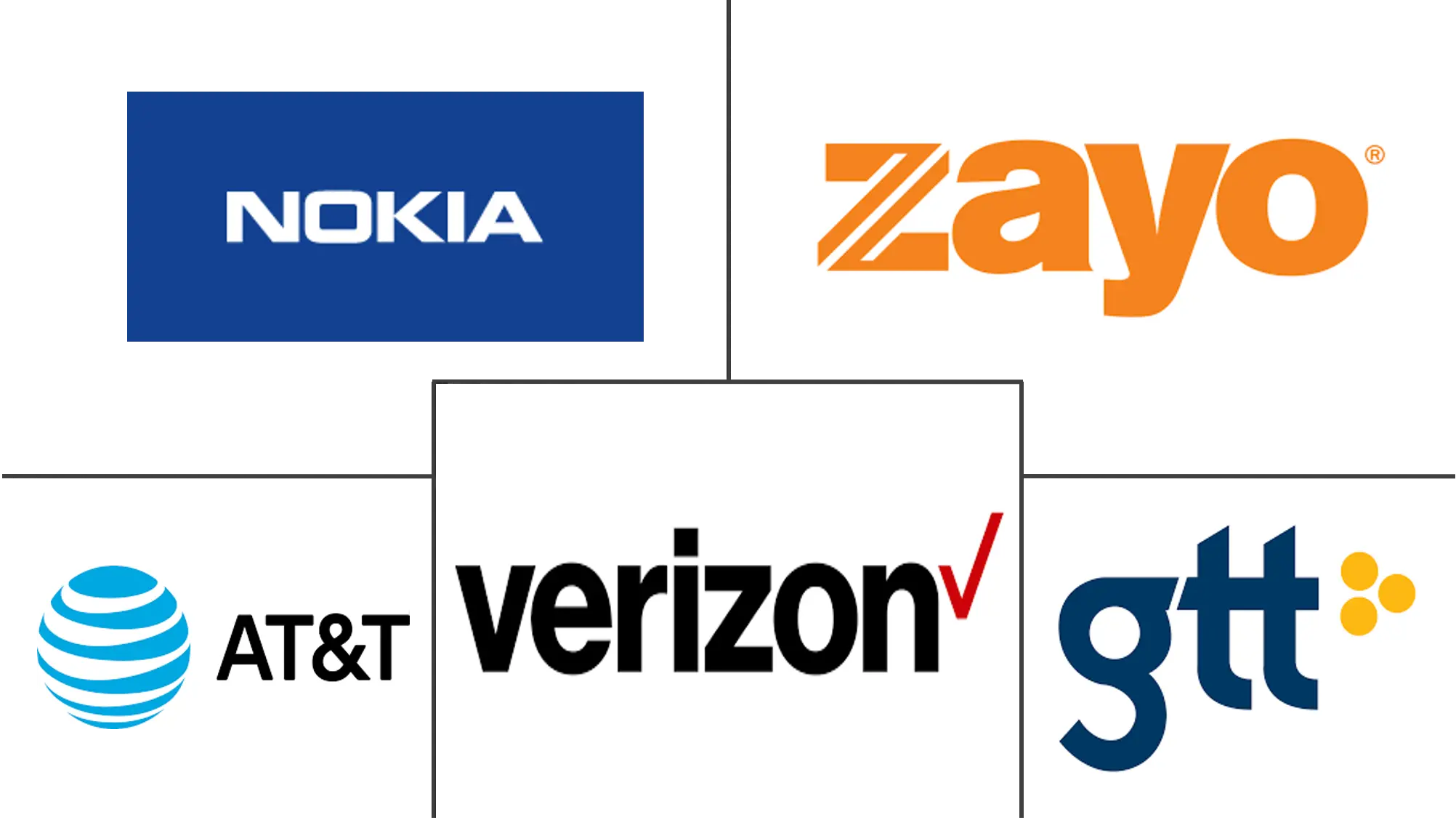Optical Wavelength Services Market Size and Share
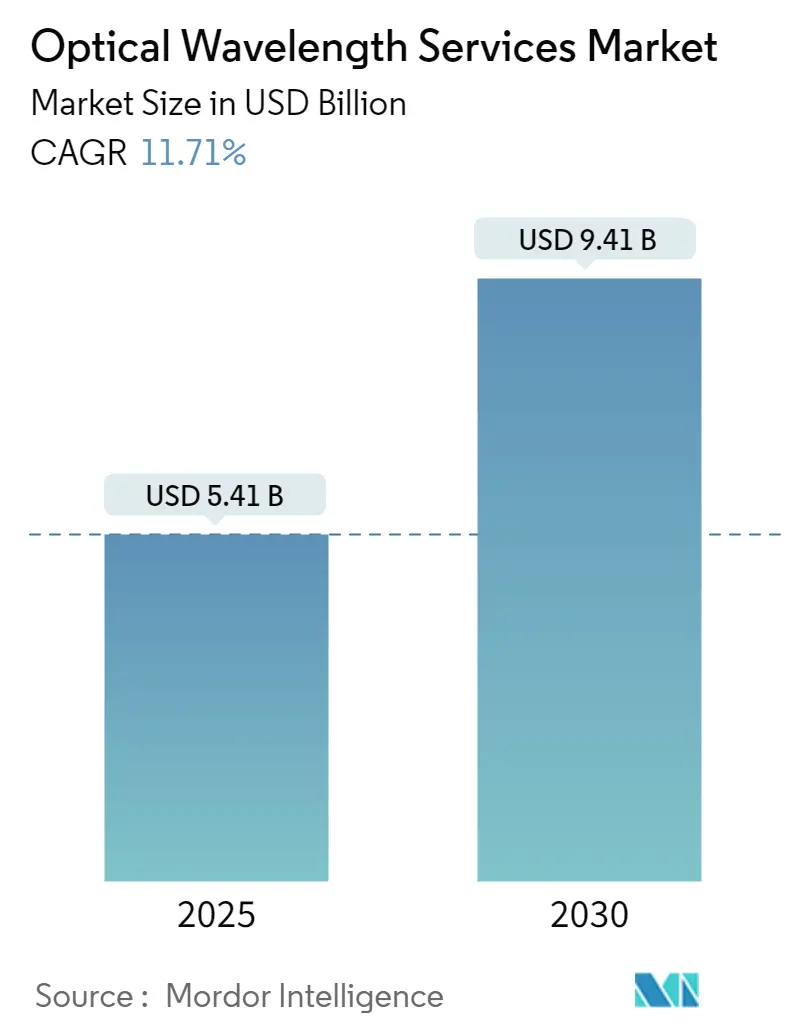
Optical Wavelength Services Market Analysis by Mordor Intelligence
The Optical Wavelength Services Market size is estimated at USD 5.41 billion in 2025, and is expected to reach USD 9.41 billion by 2030, at a CAGR of 11.71% during the forecast period (2025-2030).
- The adoption of optical wavelength services across various industries to manage bandwidth-intensive applications is driving the growth of the global optical wavelength market. The increasing demand for automation and efficient data transportation in advanced data center networking is further contributing to market expansion. Additionally, the use of optical wavelength services to optimize business expenses is supporting market growth. Furthermore, the growing focus of businesses and service providers on multimedia services, including cloud computing, voice over internet protocol (VoIP), internet of things (IoT), virtual reality (VR), and augmented reality (AR), is positively influencing the market.
- As internet penetration rises, so does the demand for high-speed data transmission, propelling the growth of the optical wavelength services market. With an increasing reliance on cloud computing, video streaming, and IoT by users and businesses alike, the demand for scalable, high-capacity networks intensifies. In response, telecom operators and enterprises are turning to wavelength-division multiplexing (WDM) technologies to boost bandwidth efficiency. This shift not only accelerates network expansions and upgrades but also fuels the market's growth. Moreover, the surging adoption of 5G technology further underscores the necessity for robust optical transport networks.
- In July 2024, the German government has received approval from the European Commission to increase its fibre network funding from EUR 12 billion to EUR 38 billion. This initiative is intended to accelerate the deployment of fibre infrastructure across Germany and extend the existing state aid scheme until the end of 2028. The additional funding enables local authorities to either develop their own fibre networks or outsource both deployment and operational responsibilities.
- In February 2024, Telia Lithuania, a subsidiary of Telia Company and a key player in telecom services, is upgrading its nationwide network with Ciena's WaveLogic 5 Extreme (WL5e) coherent optics. This upgrade not only supports 400G services but also marks the debut of an 800Gb/s wavelength service, connecting major cities across Lithuania. Due to this enhancement, Telia Lithuania is poised to offer transport services that are not only more flexible and higher in capacity but also cost-effective. These services come with the resilience and power efficiency essential for 5G, the Internet of Things (IoT), and other bandwidth-hungry applications.
- However, high initial infrastructure costs restrain the optical wavelength services market, particularly limiting adoption by smaller enterprises. Deployment efficiency can be hindered by challenges in complex network management and integration. Security concerns, notably the risk of data interception in shared wavelength networks, add to these challenges. Market expansion is restricted by limited fiber availability in remote or underdeveloped regions. Regulatory and compliance requirements can decelerate network deployments. Furthermore, competition from alternative networking solutions, including SD-WAN and satellite communication, poses a challenge to market growth.
Global Optical Wavelength Services Market Trends and Insights
100 Gbps Segment is Expected to Hold Significant Market Share
- Industries demanding high-speed, low-latency, and secure data transmission increasingly rely on 100G optical wavelength services. These services play a pivotal role in various applications: They connect 5G cell towers to core networks, powering ultra-fast mobile data services. They link data centers at high speeds, supporting cloud computing, storage, and disaster recovery. Stock exchanges and banks benefit from them for low-latency trading, secure transactions, and real-time data synchronization. In the medical field, they enable real-time imaging, telemedicine, and the secure transfer of large patient data files.
- 100G DWDM technology, pivotal for high-speed optical communications, facilitates high-capacity transmission over a single wavelength, even across extended distances. Coherent CFP/CFP2/CFP4 DWDM optical transceivers cater to 100G MAN (Metropolitan Area Network) or DCI (Data Center Interconnection) needs, supporting distances up to 80 km and long-haul links exceeding 1000 km. These transceivers adeptly transport multiple 10G, 40G, and 100G services, addressing the surging demand for bandwidth. Furthermore, the integration of a 100G DWDM transponder/muxponder not only sidesteps the need for a network architecture redesign but also ensures seamless transitions between 10G, 40G, and 100G services, thanks to its ability to multiplex multiprotocol and multi-rate services.
- The players in the market are providing new solutions to cater market needs. For example, PacketLight's muxponders and transponders now deliver a robust 100G capacity over a single wavelength. Leveraging GCM-AES-256 standards and the Diffie-Hellman (DH) Key Exchange, embedded Layer-1 encryption ensures secure transport, whether on a per-service basis or for an entire 100G uplink. This encryption, applied over the 100G spectrum, accommodates a range of services: 10/40/100Gb Ethernet, 8G/16G/32G Fibre Channel, OTU2/2e/OTU3/OTU4, and OC-192/STM-64. The benefits are manifold: All data transmitted over the fiber is encrypted without omissions, ensuring transparency and maintaining the full bandwidth of the traffic. This is especially advantageous for low-latency applications, and also cover physical fiber tapping detection.
- Similarly, in 2023, CableLabs has unveiled the Architecture Specification for its Coherent Passive Optical Networks (CPON) 100 Gbps (100G) Single Wavelength PON. Boasting enhanced capacity per wavelength, a broader reach, and increased port density, CPON marks a significant leap forward for next-gen broadband access via fiber optics. This inaugural specification, part of a forthcoming series, is designed to equip CableLabs members with the requisite bandwidth and tools, positioning them at the forefront of the broadband industry.
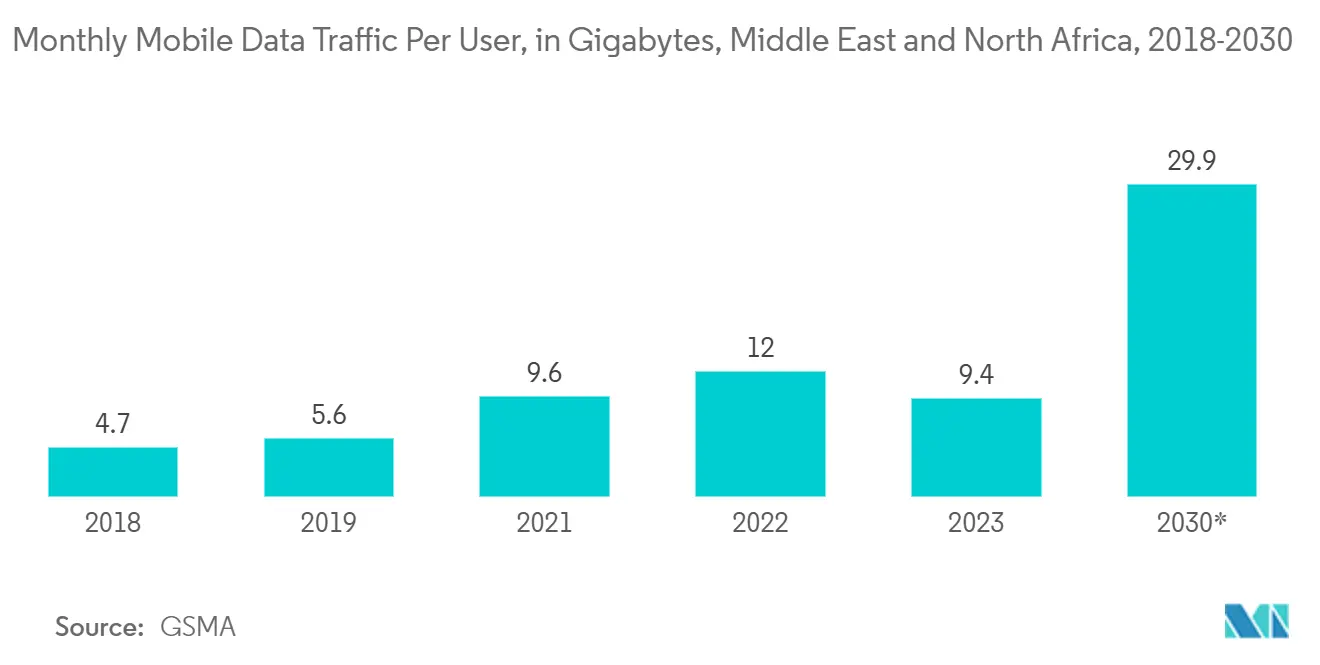
North America is Expected to Hold Significant Market Share
- The growing demand for Optical Wavelength Services in North America is driven by the need for secure transport of substantial workloads, catering to data centers and other sites that demand high-capacity connectivity with ultralow latency. As organizations in the region prioritize safeguarding their mission-critical data, they're turning to alternative backup and recovery solutions. Given its ultra-high-bandwidth capabilities, Optical Wavelength Services is the premier choice for disaster recovery in the cloud, data center, or colocation settings.
- For instance, in May 2024, FiberLight, LLC, a fiber infrastructure provider boasting over 20 years in crafting and managing high-bandwidth networks, unveiled its expanded optical Wavelength services. This expansion includes a new Point of Presence (POP) at the Globalinx data center and cable landing station in Virginia Beach, Virginia, USA, showing the demand for the market in the Data center facilities.
- Additionally, Verizon's U.S. Wavelength service, utilizing an InterLATA (Inter Local Access and Transport Area) 2.5 Gbps (Gigabits per second) or 10 Gbps optical circuit, delivers signals over the IXC (Interexchange Carrier) network. These signals can be either unprotected (2 wire) or protected (4 wire) due to Dense Wave Division Multiplexing (DWDM). This service is pivotal for high-speed point-to-point and multipoint connections, playing a crucial role in disaster recovery and ensuring data center integrity, showing the need for optical wavelength services in the data centers. The growth of data center constructions in the USA and Canada region during the forecast period would create growth opportunities for the studied market.
- Technological advancements, like Ciena's WaveLogic 5 Extreme, are propelling the market growth. This technology facilitates high-capacity wavelength services, transmitting vast data volumes (up to 800 Gbps) on a single optical wavelength. As a result, it offers high-bandwidth connectivity over long distances through one wavelength channel, presenting a significant opportunity for optical wavelength service providers in North America.
- For instance, in May 2024, Conterra Networks, a national leader in fiber-optic infrastructure and services, harnesses Ciena's top-tier WaveLogic 5 Extreme (WL5e) technology. This enables Conterra to provide 400Gb/s wavelength services to carrier clients across Texas, North Carolina, and Louisiana. In a significant achievement, Conterra boosted its fiber capacity by an impressive 30%, sidestepping the need for substantial infrastructure expansions. Across the U.S., Contreras experts have been at the forefront, designing, building, and operating advanced telecom networks for sectors like education, healthcare, enterprise, and carriers; this shows the demand for optical wavelength services across the IT and telecom security companies in the North American region.
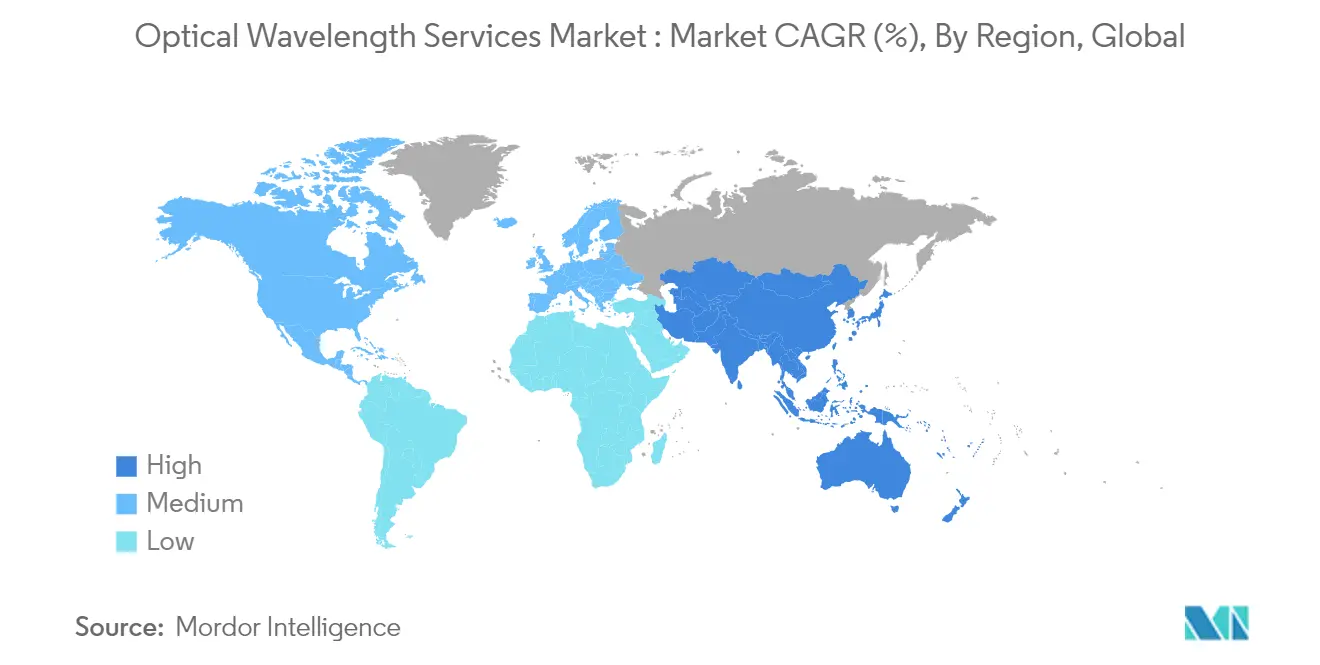
Competitive Landscape
The Optical Wavelength Services Market currently experiences moderate competition, but this sector is expected to grow as vendors plan new product launches, partnerships, and acquisitions. Some of the market leaders in this segment include Zayo Group, Nokia, Century Link, Verizon Wireless, Century Link, and Windstream Communications. Compared to other network setups, optical wavelength networks offer a scalable solution that can quickly increase capacity to combat slower data transfer speeds or address traffic bottlenecks.
Optical Wavelength Services Industry Leaders
-
Nokia Corporation
-
Zayo Group Holdings, Inc.
-
Verizon Communications Inc.
-
GTT Communications, Inc.
-
AT&T Inc.
- *Disclaimer: Major Players sorted in no particular order
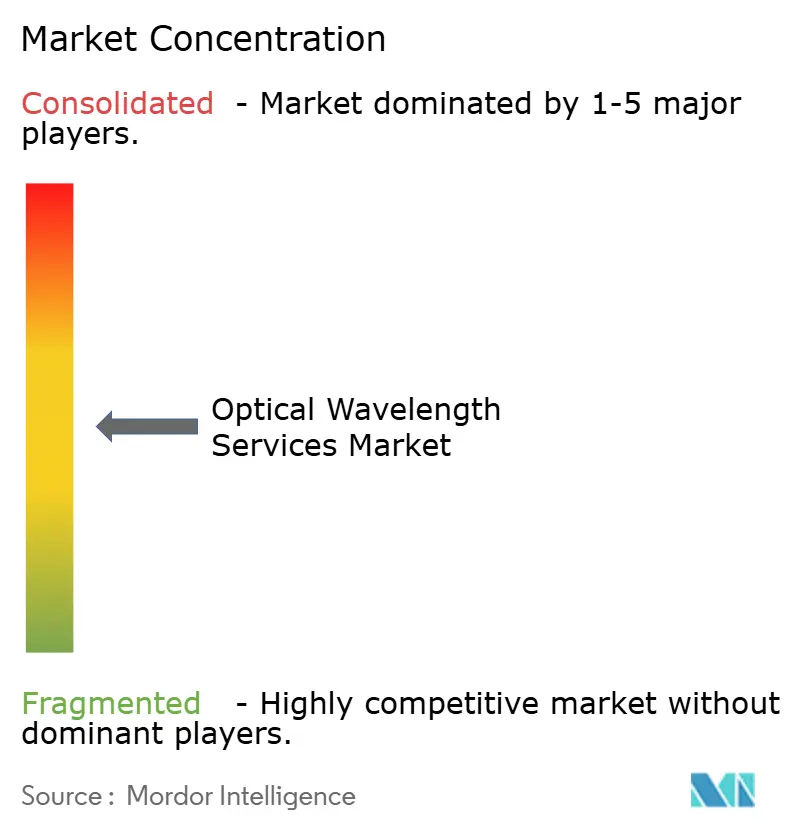
Recent Industry Developments
- January 2025: Vocus Group Limited, a digital infrastructure provider in Australia, invested significantly in product innovation by rolling out its 400G terrestrial inter-capital services, connecting the nation's east and west coasts. These advanced systems deliver 400G Wavelength Ethernet speeds, linking Sydney, Melbourne, and Brisbane in the east with Adelaide and Perth in the west.
- May 2024: Cogent Communications Holdings, Inc. announced its ambition to roll out wavelength services across more than 800 sites. After acquiring Sprint's wireline network, Cogent Communications Holdings, Inc. focuses on expanding its presence in the optical wavelength and transport services sector.
Global Optical Wavelength Services Market Report Scope
Multiple high-bandwidth channels can be transmitted in a single strand of fiber by using dense wavelength division multiplexing (DWDM) technology. High wavelengths are ideal for large multi-site businesses and high-capacity data center transport and carriers. To meet growing bandwidth demands, Wavelength Services expedites the introduction of optical connectivity without incurring significant upfront costs.
The global optical wavelength services market is segmented by bandwidth (less than 10 Gbps, 40 Gbps, 100 Gbps, more than 100 Gbps) and geography (North America, Asia-Pacific, Europe, and the Rest of the World). The market sizes and forecasts are provided in terms of value (USD) for all the above segments.
| 10G |
| 40G |
| 100G |
| 200G |
| 400G and above |
| IT & Telecom |
| BFSI (Banking, Financial Services, and Insurance) |
| Healthcare |
| Government |
| Others |
| North America |
| Europe |
| Asia |
| Australia and New Zealand |
| Latin America |
| Middle East and Africa |
| By Wavelength Capacity | 10G |
| 40G | |
| 100G | |
| 200G | |
| 400G and above | |
| By End User Industry | IT & Telecom |
| BFSI (Banking, Financial Services, and Insurance) | |
| Healthcare | |
| Government | |
| Others | |
| By Geography | North America |
| Europe | |
| Asia | |
| Australia and New Zealand | |
| Latin America | |
| Middle East and Africa |
Key Questions Answered in the Report
How big is the Optical Wavelength Services Market?
The Optical Wavelength Services Market size is expected to reach USD 5.41 billion in 2025 and grow at a CAGR of 11.71% to reach USD 9.41 billion by 2030.
What is the current Optical Wavelength Services Market size?
In 2025, the Optical Wavelength Services Market size is expected to reach USD 5.41 billion.
Who are the key players in Optical Wavelength Services Market?
Nokia Corporation, Zayo Group Holdings, Inc., Verizon Communications Inc., GTT Communications, Inc. and AT&T Inc. are the major companies operating in the Optical Wavelength Services Market.
Which is the fastest growing region in Optical Wavelength Services Market?
Asia Pacific is estimated to grow at the highest CAGR over the forecast period (2025-2030).
Which region has the biggest share in Optical Wavelength Services Market?
In 2025, the North America accounts for the largest market share in Optical Wavelength Services Market.
What years does this Optical Wavelength Services Market cover, and what was the market size in 2024?
In 2024, the Optical Wavelength Services Market size was estimated at USD 4.78 billion. The report covers the Optical Wavelength Services Market historical market size for years: 2019, 2020, 2021, 2022, 2023 and 2024. The report also forecasts the Optical Wavelength Services Market size for years: 2025, 2026, 2027, 2028, 2029 and 2030.
Page last updated on:
Optical Wavelength Services Market Report
Statistics for the 2025 Optical Wavelength Services market share, size and revenue growth rate, created by Mordor Intelligence™ Industry Reports. Optical Wavelength Services analysis includes a market forecast outlook for 2025 to 2030 and historical overview. Get a sample of this industry analysis as a free report PDF download.
